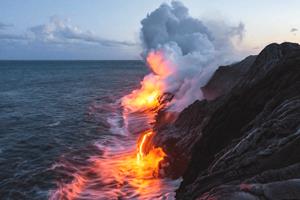Most visitors to Hawaiʻi come to experience the beautiful outdoors and natural beauty of this unique island chain. While many resort areas are beautifully manicured and landscaped for your enjoyment, for the real awe-inspiring experiences, you’ll need to travel to the wilder places that only nature’s power can create. Check out these five unique places, and you’ll be so glad you ventured off the golf course! Come explore Hawaii nature
Kīlauea Volcano
It’s possibly the most-visited volcano on earth, and for many good reasons: It’s a national park, orderly and well-kept; its visitor attractions are many, including art centers, a historic hotel, and great interpretive exhibits; and it’s also one of the most well-monitored volcanoes on the planet, so you know you’re safe when traveling there. Hawaiʻi Volcanoes National Park, and its active volcano, Kīlauea, are the number-one attraction on Hawaiʻi Island. The park is so vast, it’s hard to see it all in one day, so consider spending a night in the area to stretch your visit out over two. Choose your desired level of adventure: simply drive to a multitude of scenic overlooks, or embark on a rugged backcountry hiking adventure. Check the park website for current viewing conditions and area closures.
Mauna Kea
The tallest mountain in the Pacific (and tallest on earth if you count from the sea floor), Mauna Kea is world-renowned as one of the best astronomical observatories on the planet. It’s also considered sacred to many native Hawaiians. The summit is only reached by 4-wheel drive road, and is not suitable for some visitors with certain health conditions due to the high altitude. However, nearly everyone can enjoy the expansive views at the Mauna Kea Visitors’ Center. It’s an incredible place to watch the sun rise or set, but don’t forget your winter clothes!
Kealakekua Bay
Kealakekua is best known as the place where Captain Cook met his end in 1778, however, the Cook Monument is only one of many reasons to visit. This beautiful bay is well known as an amazing place to snorkel and kayak. There’s really no beach to speak of, and it’s important to practice reef safety here: don’t touch or step on the corals, and make sure to use reef-safe sunscreen. The very best snorkeling is near the Cook Monument on the “far” side of the bay, and is only accessed via the water. Consider a reputable snorkel tour boat like Fair Wind for the best viewing experience.
Waipiʻo Valley
Often called the “valley of kings” for the many high chiefs who were raised here, including ‘Umi and Kamehameha, Waipiʻo is perhaps the best-preserved example of an undeveloped Hawaiian valley on this island. Admire the incredible view from the overlook, enjoying a picnic on the rim with a takeout lunch from one of the little restaurants in Honokaʻa town. If you feel driven to explore the valley floor, just don’t drive: the road is not just 4WD only, but also extremely hazardous for those who aren’t accustomed to it. Either take the steep hike or take a tour with one of the companies in the area. Likewise, the beautiful black sand beach at the bottom has a strong undertow, powerful waves, and no lifeguard.
Ka Lae (South Point)
Finally, if you’ve ever wanted to know what it would feel like to stand at the edge of the world, head down to Ka Lae, the southernmost tip of the island (and of the United States). The rugged terrain drops off abruptly into deep blue open ocean; enjoy watching the local kids jump, but keep in mind that there are powerful currents (and extremely big fish) down there. Ka Lae is a wild, windswept place, like no other you’ll find anywhere. It’s a must for any Hawaii natural attractions!
Contact us to learn more about Hawaii natural features!
















